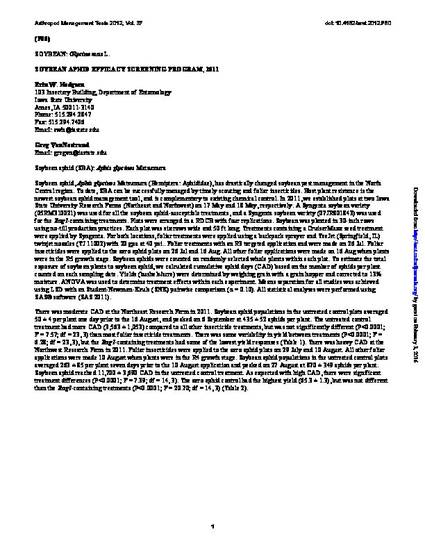Publication Version
Published Version
Publication Date
1-1-2012
DOI
10.4182/amt.2012.F80Soybean aphid, Aphis glycines Matsumura (Hemiptera: Aphididae), has drastically changed soybean pest management in the North Central region. To date, SBA can be successfully managed by timely scouting and foliar insecticides. Host plant resistance is the newest soybean aphid management tool, and is complementary to existing chemical control. In 2011, we established plots at two Iowa State University Research Farms (Northeast and Northwest) on 17 May and 18 May, respectively. A Syngenta soybean variety (05RM310021) was used for all the soybean aphid-susceptible treatments, and a Syngenta soybean variety (07JR801843) was used for the Rag1-containing treatments. Plots were arranged in a RDCB with four replications. Soybean was planted in 30-inch rows using no-till production practices. Each plot was six rows wide and 50 ft long. Treatments containing a CruiserMaxx seed treatment were applied by Syngenta. For both locations, foliar treatments were applied using a backpack sprayer and TeeJet (Springfield, IL) twinjet nozzles (TJ 11002) with 20 gpa at 40 psi.. Foliar treatments with an R3 targeted application and were made on 26 Jul. Foliar insecticides were applied to the zero aphid plots on 26 Jul and 16 Aug. All other foliar applications were made on 16 Aug when plants were in the R5 growth stage. Soybean aphids were counted on randomly selected whole plants within each plot. To estimate the total exposure of soybean plants to soybean aphid, we calculated cumulative aphid days (CAD) based on the number of aphids per plant counted on each sampling date. Yields (bushels/acre) were determined by weighing grain with a grain hopper and corrected to 13% moisture. ANOVA was used to determine treatment effects within each experiment. Means separation for all studies was achieved using LSD with an Student-Newman-Keuls (SNK) pairwise comparison (α = 0.10). All statistical analyses were performed using SAS® software (SAS 2011).
Abstract
Soybean aphid, Aphis glycines Matsumura (Hemiptera: Aphididae), has drastically changed soybean pest management in the North Central region. To date, SBA can be successfully managed by timely scouting and foliar insecticides. Host plant resistance is the newest soybean aphid management tool, and is complementary to existing chemical control. In 2011, we established plots at two Iowa State University Research Farms (Northeast and Northwest) on 17 May and 18 May, respectively. A Syngenta soybean variety (05RM310021) was used for all the soybean aphid-susceptible treatments, and a Syngenta soybean variety (07JR801843) was used for the Rag1-containing treatments. Plots were arranged in a RDCB with four replications. Soybean was planted in 30-inch rows using no-till production practices. Each plot was six rows wide and 50 ft long. Treatments containing a CruiserMaxx seed treatment were applied by Syngenta. For both locations, foliar treatments were applied using a backpack sprayer and TeeJet (Springfield, IL) twinjet nozzles (TJ 11002) with 20 gpa at 40 psi.. Foliar treatments with an R3 targeted application and were made on 26 Jul. Foliar insecticides were applied to the zero aphid plots on 26 Jul and 16 Aug. All other foliar applications were made on 16 Aug when plants were in the R5 growth stage. Soybean aphids were counted on randomly selected whole plants within each plot. To estimate the total exposure of soybean plants to soybean aphid, we calculated cumulative aphid days (CAD) based on the number of aphids per plant counted on each sampling date. Yields (bushels/acre) were determined by weighing grain with a grain hopper and corrected to 13% moisture. ANOVA was used to determine treatment effects within each experiment. Means separation for all studies was achieved using LSD with an Student-Newman-Keuls (SNK) pairwise comparison (α = 0.10). All statistical analyses were performed using SAS® software (SAS 2011).
Copyright Owner
Entomological Society of America
Citation Information
Erin W. Hodgson and Greg VanNostrand. "Soybean aphid efficacy screening program, 2011"
Arthropod Management Tests Vol. 37 Iss. 1 (2012) p. F80
Available at: http://works.bepress.com/erin_hodgson/278/


This article is from Arthropod Management Tests 37 (2012): F80, doi:10.4182/amt.2012.F80. Posted with permission.